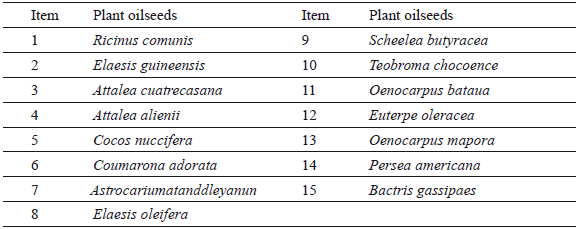Serviços Personalizados
Journal
Artigo
Indicadores
-
 Citado por SciELO
Citado por SciELO -
 Acessos
Acessos
Links relacionados
-
 Citado por Google
Citado por Google -
 Similares em
SciELO
Similares em
SciELO -
 Similares em Google
Similares em Google
Compartilhar
DYNA
versão impressa ISSN 0012-7353versão On-line ISSN 2346-2183
Dyna rev.fac.nac.minas v.78 n.170 Medellín dez. 2011
PRELIMINARY ANALYSIS OF BIOMASS POTENTIALLY USEFUL FOR PRODUCING BIODIESEL
ANALISIS PRELIMINAR DE BIOMASA POTENCIALMENTE ÚTIL PARA PRODUCIR BIODIESEL
GERARDO CABRERA CIFUENTES
M.Sc.Mechanical Engineering School, University of Valle, Cali, Colombia, gcabrera@univalle.edu.co
JUAN CARLOS BURBANO JARAMILLO
Ph.D.Mechanical Engineering Faculty, Technological University of Pereira, Pereira, Colombia, jburbano@utp.edu.co
JOSÉ ISIDRO GARCIA MELO
Ph.D Mechanical Engineering School, University of Valle, Cali, Colombia, jose.i.garcia@correounivalle.edu.co
Received for review March 31th, 2010, accepted August 5th, 2010, final version August, 10th, 2010
ABSTRACT: Given that biodiesel is emerging as a viable solution for some energy and environmental problems, research on raw materials appropriate for its production is a matter of growing interest. In this study we present the results of research devoted to preliminary analysis on several vegetable (biomass) species potentially useful for producing biodiesel. The bioprospection zone is a region on the Colombian Pacific coast. The candidate species collected underwent different standardized ASTM tests in order for us to define properties that facilitate their evaluation. Some of the species underwent a transesterification process. Comparisons between the thermo-physical properties of the biofuels obtained and the properties of commercial diesel were carried out. Also, performance tests for these biofuels were conducted in compression ignition engines, particularly evaluating efficiency, fuel consumption, and potency at different RPMs.
KEY WORDS: Biodiesel, biofuel, transesterification, internal combustion engines
RESUMEN: Considerando que el biodiesel se está convirtiendo en una solución viable para algunos problemas energéticos y medioambientales, la investigación de materias primas para su producción es un tema de creciente interés. Este estudio presenta los resultados de una investigación dedicada al análisis preliminar de varias especies vegetales (biomasa), potencialmente útiles para producir biodiesel. La zona de bioprospección es una región de la costa pacifica colombiana. Las especies promisorias recolectadas fueron sometidas a diferentes pruebas normalizadas ASTM para definir propiedades que faciliten su evaluación. Algunas de las especies fueron sometidas a un proceso de transesterificación. Adicionalmente, se realiza una comparación entre las propiedades termo-físicas de los biodiesel y las propiedades del diesel comercial. Las pruebas de rendimiento de estos biocombustibles en los motores de encendido por compresión, particularmente la eficiencia, el consumo y la potencia a diferentes RPM del motor, se presentan en este trabajo.
PALABRAS CLAVE: Biodiesel, biocombustibles, motores de combustión interna
1. INTRODUCTION
Currently, scientists and economists have focused their efforts on finding new energy resources. Biomass ranks fourth as an energy resource worldwide, accounting for approximately 14 % of the world's energy needs; moreover, biomass is the most important energy resource in developing nations, providing 35 % of their energy [1]. Demirbas reviewed different biomass technologies such as biomass conversion into biodiesel, among others [2]. Additionally, there is an urgent need of substitutes for petroleum-based fuels, if one takes into account the environmental/economic costs and the fact that it is a non-renewable resource, among other characteristics [3]. Moreover, this has already encouraged the use of biomass as a complementary energy source in developed countries [4,5,6]. In this context, a promising alternative to petroleum-based fuels is known as biodiesel, which, in general terms, are molecules of triglycerides (three long-chain fatty acids linked with glycerol molecules by an ester). In addition, a technical definition for biodiesel is a fuel comprising mono-alkyl esters of long-chain fatty acids derived from vegetable oils or animal fats, designated B100, and meeting the ASTM D 6751 requirements.
Usually, the catalyzing of vegetable oil to get biodiesel can be done with an alkali, with an acid, or an enzyme [7]. The alkali method was used in this study. Various authors have presented works about plants as raw materials for biodiesel. In [1] the combustion characteristics of different biomass fuels are presented. In [8] the biodiesel production using soybean and sunflower is shown. A reference of potential for producing bio-fuel in the Amazon deforested areas is realized in [9]. In [10] the potential bioethanol and biogas production using lignocellulosic biomass from winter rye, oilseed rape (also known as rapeseed or Brassica napus), and faba bean is studied. An analysis of the properties of biodiesel from palmoil is realized in [11]. In [12], a tobacco seed oil and tobacco seed oil methyl ester has been tested in diesel engines. In [13], a technique for producing biodiesel from mahua oil (Madhuca indica) having high free fatty acids (19 % FFA) has been developed. In [14] a process for converting the Jojoba oil-wax to biodiesel by transesterification with methanol, catalysed with sodium methoxide is discussed.
In general, biodiesel has the advantage of being derived from potentially renewable sources, it is also biodegradable, non-toxic, and its use reduces the emission of greenhouse gases, sulphur oxides, and the total unburned hydrocarbons. In addition, their production could be sustainable [7]. However, the current high production cost is considered to be one of its main competitive constrains being estimated between 70-95 % depending on the raw material [15]. Moreover, another obstacle is the high viscosity (10-20 times greater) compared to diesel, resulting in fuel injector troubles in injection engines. However, by expanding the array of cost assessment to include environmental costs, the economic balance leans toward bio-fuels [16,17]. In [18], a techno-economic analysis of a process that produces biodiesel from vegetable oils is presented with the aim of researching the dependence of the critical profitability indicators on the production capacity.
For all above mentioned arguments, finding and identifying vegetable oils (bioprospection) available within an area of the Colombian Pacific coast which would be promising for biodiesel production is one of the tasks necessary for achieving advantages in fuel switching and legitimizing its use, justifying the aim of this work.
This paper is structured as follows: We initially describe the bioprospection area where the set of plants was selected; then we present results on standardized tests (ASTM) for the various species studied; thereafter, mechanical performance experiments are carried out; and finally, the conclusions and comments are presented.
2. BIOPROSPECTION ZONE
The bioprospection area for this study is located in Colombia (Fig. 1). This country is characterized by different geographic areas and thermal floors, which may present abundant sunshine and water, as well as a correspondingly high biodiversity. One of these areas is called the Pacific Plain (Fig. 1[b]), which is a large tropical jungle plain between the Pacific Ocean and the western Colombian mountains. This zone has different characteristics including lush vegetation, abundant water resources, a high pluviometric index, beaches, and forests adjacent to the Pacific Ocean with little interference from civilized man, among others, which contribute positively in a high rate of biodiversity [19]. In the Colombian Pacific coast area are the states of Choco, Valle del Cauca, Cauca, and Nariño.
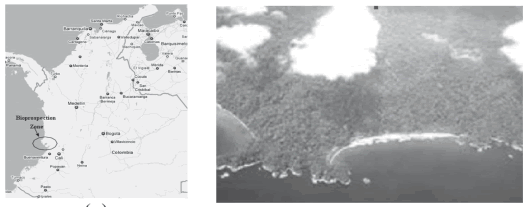
Figure. 1. Bioprospection zone: (a) location in Colombia, (b) appearance of Pacific coast
The Colombian Pacific Region is a strip of 75,000 kilometers between the countries of Panama and Ecuador. This region has a high concentration of biodiversity in terms of the number of species per hectare thanks to the combination of soil, water, and climate, coupled with a near zero interference in evolutionary natural processes. With regard to this, approximately 9,000 species of the 45,000 registered species in Colombia are present in the Pacific Coast, particularly in the state of Choco. Due to all aspects discussed above, this region was selected as the bioprospection area for this study.
In the bioprospection area, 15 oilseeds were collected (Table 1), and different ASTM tests were carried out in order to determine their fuel characteristics.
3. OIL EXTRACTION AND CHARACTERIZATION OF BIO-OILS
3.1 Oil extraction
Vegetable oil was initially extracted from the selected plant species by compression or dissolution using a solvent, then their extraction efficiencies (R), were determined according to Eq. (1) where it corresponds to the relation between the quantity of vegetable oil recovery (moil) and the quantity of the original raw material (mraw material).

The extraction of these substances is generally easy. The methods used are: cold compression, warm compression, water-steam flow, and dissolution with an appropriate solvent. For this research, the extraction with pressure (compression) and a dissolvent was used.
Table 2 shows the extraction efficiency, the extraction method, and the vegetable species selected. The first four species present an extraction efficiency of around 45 %, and the worst extraction efficiency was Bactris gassipaes with 9.7 %.
Table 2. Efficiency, extraction method, and presentation of vegetable species
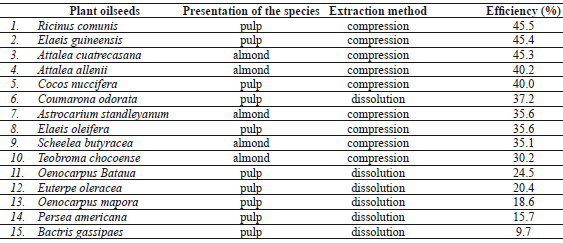
3.2 Characterization of bio-oils
We must consider that oil application depends on its thermo-physics properties such as: density, cinematic viscosity, flame point, solidification point, humidity, sediment, ashes, and heat value, among others. The bio-oils obtained after the extraction stage underwent eight different tests based on standardized ASTM methods. Specific gravity and API grades are calculated. The sulphur content was determined according to AOAC methods (Table 3).
Table 3. Different tests and normalized methods for bio-oils
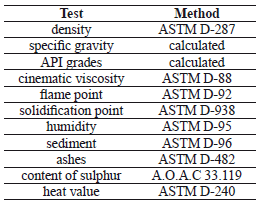
The values of density, API grades and cinematic viscosity at temperatures of 40 oC and 100 °C, are presented in Table 4. Additionally, in the same table, the values of these properties for diesel and marine diesel also appear.
Table 4. Different property values for the species studied
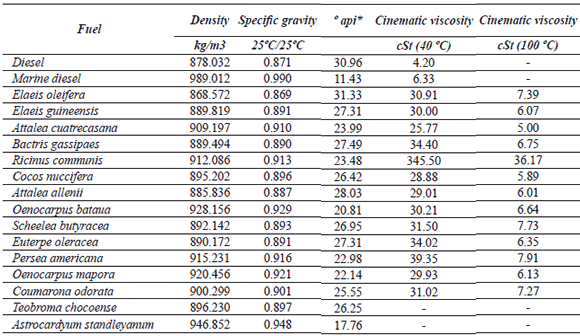
As can be seen in the table above (Table 4), we should note that the viscosity of the vegetable oils with values between 25 and 40 cSt, and the diesel and marine diesel, with viscosities of 4.2 and 6.33 (at 40 oC), differ from the Riccinus communis with 345 cSt.
The values of humidity, sediment, ashes, heat value, and flame temperature properties are shown in Table 5.
Table 5. Humidity, sediment, ashes, heat value, and flame temperature for the species studied
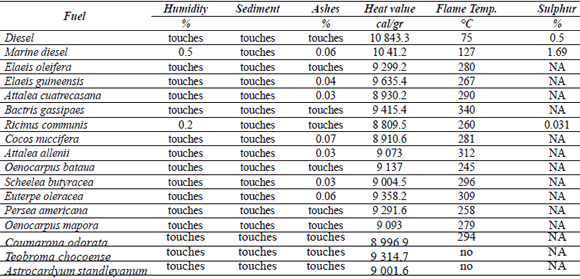
As shown in Table 5, the heat value of all biodiesel is similar (around 9200 cal/gr), and is low with regards to diesel and marine diesel. A low value in the power heat (heat value) means that each kilogram of burned fuel delivers less heat to be transformed into work transferred to the engine axis and therefore major quantities of fuel are required to obtain the same quantity of work.
The relative density of the oil is measured in American Petroleum Institute (API) grades. The oils of more of 30 API grades are considered to be light. Those which have less than 30 API grades, but more than 22, qualify as medium. Those which have less than 22 API grades but more than 10 API grades are considered to be heavy. The oils of less than 10 API grades are extra-weighed, of which those of minor density are qualified, like bitumen.
In accordance with the values of API grades obtained, it is possible to consider that the majority of the bio-oils studied fall into the category of medium, coming closer to commercial diesel, with the exception of number 8, oenocarpus bataua and number 15, tastrocardyum standleyanum, which fall into the category of heavy oil.
Figure 2 shows the values of API grades for the different species studied.
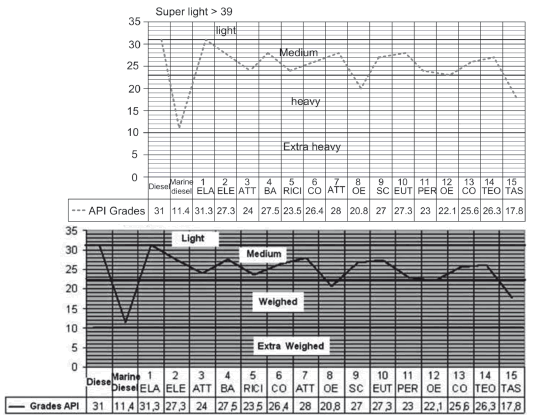
Figure 2. API grade values for the different species studied
4. MECHANICAL PERFORMANCE
The direct use of vegetable oils has problems with the engine due principally to: its high viscosity which makes its flow difficult-increasing the pressure of injection and the deposits in the injectors-, its low volatile nature that make engine ignition difficult. It is necessary to transform the vegetable oil into something similar to diesel. Some methods to obtain biodiesel similar to commercial diesel are: pyrolysis, micro-emulsification, dilution, and transesterification (Maa & Hannab, 1999). For this present research, the transesterification method was used.
The oils selected to be transesterificated were: Elaeis oleífera (biodiesel A), Elaeis guineensis (biodiesel B), and Ricinus comunis (biodiesel C). It was observed that the biodiesel that adjusted itself better to the international regulations are Elaeis guineensis and Elaeis oleifera. As an additional characteristic, the cetane index was evaluated for this combustible, finding a value of 50. In all the cases, a considerable reduction of the flame point and a light increase of the heat value appear in the biodiesel-with respect to its original state.
A comparison of characteristics of the fuels studied with two kind of biodiesel from palm oil (biodiesel 1, treated with methanol; and biodiesel 2, treated with ethanol) and the commercial diesel, is presented in Table 6.
Table 6. Comparison of the characteristics of different kind of biodiesel

At 40 °C, the biodiesels that can be used in an internal combustion engine are: elaeis guineensis and elaeis oleifera because the others exceed the limit of 6 cSt; however, all biodiesels can be used up to 100 °C. In order to do that, a warming up of the engine before input must be carried out by modifying the combustion system.
The biodiesel efficiency curves were drawn based on tests the essays of applicability of palm oil biodiesel in power generation. The estimated efficiencies for different rpms, of different biodiesel are shown in Table 7; and the estimated potencies (in HP) are shown in Table 8.
Table 7. Estimated efficiencies

Tests were carried out on a dynamometer for diesel and palm biodiesel. By comparatively evaluating the incidence of the different properties in the biodiesel obtained, the behavior was discovered in power generation.
Biodiesel A, B, C, and biodiesel 1 and 2, were compared with commercial diesel, finding that all the first ones present major similarities with biodiesel 2 (the biodiesel of palm olein).
Figure 3 synthesizes the behavior of each biodiesel and commercial diesel with respect to consumption and power. Figures 3a, 3b, and 3c correspond to biodiesel A, biodiesel B, and biodiesel C, respectively, displaying the consumption and axis power tendency, relative to the revolutions in the engine axis.
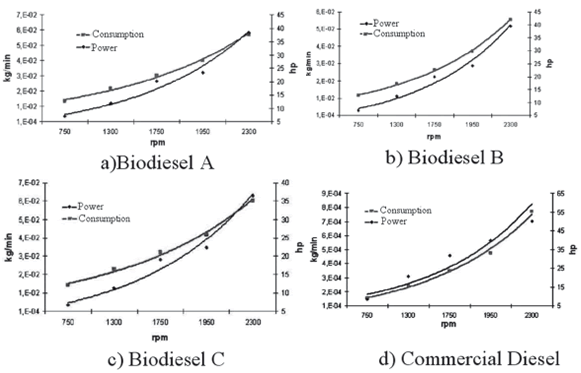
Figure 3. Behavior of each biodiesel and commercial diesel with respect to consumption and power
The curves in Figure 3 show how the engine has a good fuel consumption/power relationship when revolutions increase approaching approximately 2300 rpm. For commercial diesel, the behavior in the fuel consumption/power relationship is practically constant throughout different RPMs, as can be seen in Figure 3d. The corresponding power at 2300 RPM were different for each type of fuel, about 40 hp in biodiesel A and B, and near 34 hp in biodiesel C. On the commercial biodiesel curve, it is possible to note that output power is greater.
5. CONCLUSIONS
Due to their potential use as raw materials in the production of biodiesel, a bio-prospect and characterization of 15 oily vegetable species was presented in this work. The bio-oils studied can be used directly in diesel engines, but due to the fact that they present a high viscosity in relation to diesel and marine diesel, transesterification is recommended.
When using oils for internal combustion engines, high viscosity can cause wear in the conduits and obstruction-particularly in narrow orifices like those of injectors.
In comparison to standard diesel, biodiesel has less power delivered at an equal level of consumption, which is explained by the lower heat value, and also sometimes by the difference in viscosity. High viscosity may hamper the intimate contact between drops of fuel and oxygen within the combustion chamber of the engine being tested. This opens a field of research and development in the fuel-combustion system according to the type of biodiesel used.
The Pacific Colombian Region is a tropical, humid, and insufficiently explored region where there are a number of not yet evaluated species.
The research will have to continue to evaluate its best direct application in engines, the biodiesel manufactured methods from the extracted oils, the technical-economic and environmental plan design for its manufacturing, and to recommend terms of development for the people of the region.
ACKNOWLEDGEMENTS
The authors would like to thank Angela María Cerón and Germán Adolfo Charry for their invaluable collaboration.
REFERENCES
[1] Demirbas, A., Combustion characteristics of different biomass fuels, Progress in Energy and Combustion Science, vol. 30, (2), pp. 219-230, 2004. [ Links ]
[2] Demirbas, A., Recent advances in biomass conversion technologies, Energy Edu Sci Technol; Vol 6, pp. 19-41, 2000. [ Links ]
[3] Srivastava, A, and Prasad, R., Triglycerides based diesel fuels., Renewable and Sustainable Energy Reviews, Vol. 4, (2), pp. 111-133, 2000. [ Links ]
[4] Thornley, P., Increasing biomass based power generation in the UK, Energy Policy, Vol 34, (15), pp. 2087-2099, 2006. [ Links ]
[5] Tuck, G., Glendining, M. J., Smith, P., House, J. I, and Wattenbach, M., The potential distribution of bioenergy crops in Europe under present and future climate, Biomass and Bioenergy ,Vol 30, (3), pp. 183-197, 2006. [ Links ]
[6] Cortés, E., Suarez, H., Pardo, S. Biocombustibles y autosuficiencia energética. Revista Dyna, Vol. 158, pp. 101-110, 2009. [ Links ]
[7] Maa, F., Hannab M. A. Biodiesel production: a review, Bioresource Technology, Vol. 70, (1), pp. 1-15, 1999. [ Links ]
[8] Pimentel, D. and Patzek, T. W., Ethanol Production Using Corn, Switchgrass, and Wood Biodiesel Production Using Soybean and Sunflower, Natural Resources Research, Vol. 14, (1), pp. 65-76, 2005. [ Links ]
[9] Cunha Da Costa, R., Potential for producing bio-fuel in the Amazon deforested areas, Biomass and Bioenergy Vol. 26, (5), pp. 405-415, 2004. [ Links ]
[10] Petersson, A., Thomsen, M. H., Hauggaard-Nielsen, H., and Thomsen A., Potential bioethanol and biogas production using lignocellulosic biomass from winter rye, oilseed rape and faba bean, Biomass and Bioenergy,Vol. 31, No. 11-12, pp. 812-819, 2007. [ Links ]
[11] Kalam, M. A, and Masjuki, H. H., Biodiesel from palmoil-an analysis of its properties and potential, Biomass and Bioenergy, Vol. 23, (6), pp. 471-479, 2002. [ Links ]
[12] Usta, N., Use of tobacco seed oil methyl ester in a turbocharged indirect injection diesel engine, Biomass and Bioenergy, Vol. 28, (1), pp. 77-86, 2005. [ Links ]
[13] Shashikant, V, and Hifjur, R., Biodiesel production from mahua (Madhuca indica) oil having high free fatty acids, Biomass and Bioenergy, Vol. 28, (6), pp. 601-605, 2005. [ Links ]
[14] Canoira, L., Alcántara, R., García, M. J, and Carrasco, J., Biodiesel from Jojoba oil-wax: Transesterification with methanol and properties as a fuel, Biomass and Bioenergy ,Vol 30, (1), pp. 76-81, 2006. [ Links ]
[15] Lang, X., Dalai, A. K., Bakhshi, N. N., Reaney, M. J, and Hertz, P.B., Preparation and characterization of bio-diesels from various bio-oils, Bioresour Technol. Vol. 80, (1), pp. 53-62, 2001. [ Links ]
[16] Duncan, J., Costs of Biodiesel Production, Energy Efficiency and Conservation Authority, 2003. [ Links ]
[17] Haas, M. J., Mcaloon, A. J. and Yee, W. C., Foglia t. A process model to estimate biodiesel production costs, Bioresource Technology, Vol. 97, (4), pp. 671-678, 2006. [ Links ]
[18] Apostolakou, A., Kookos, I., Marazioti, C. and Angelopoulos, K., Techno-economic analysis of a biodiesel production process from vegetable oils, Fuel Processing Technology Vol 90, No. 7-8, pp 1023-1031, 2009. [ Links ]
[19] URUGUAY, El Chocó colombiano: una región megadiversa en un país megadiverso ¿por cuánto tiempo más?, available at http://www.wrm.org.uy/boletin/44/Colombia.html, [January 8th, 2007]. [ Links ]













